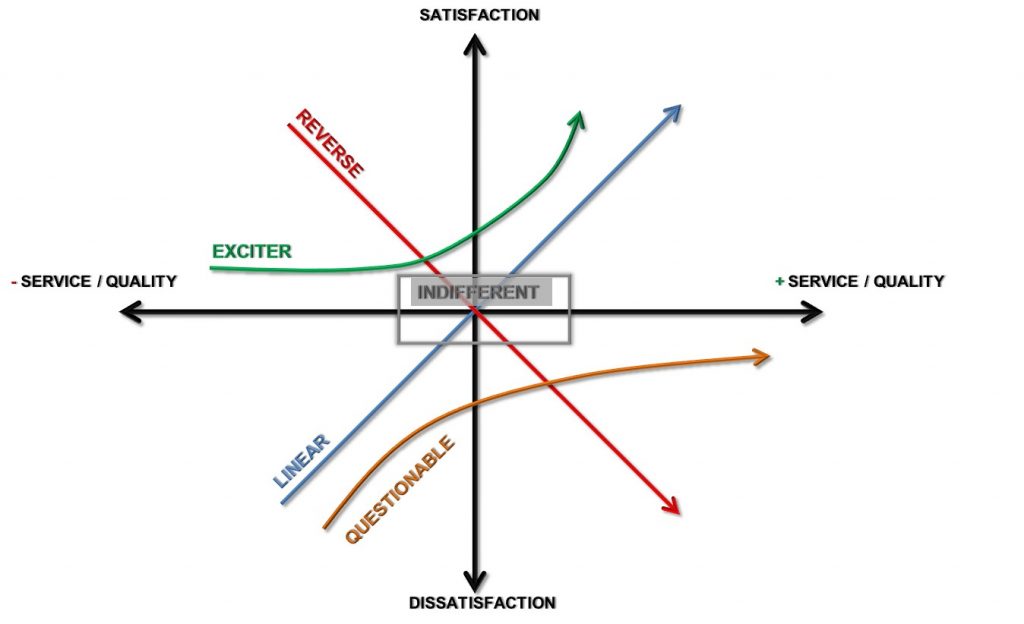The Kano Model of customer satisfaction is an interesting and intuitive tool for just about any kind of business. It’s not something I formally learned about until about a year ago, but learning it felt more like discovering something that had been around me all along than learning any sort of new process, opening my eyes to ways of applying it to my daily life in both professional and some personal scenarios.
For a quick and dirty explanation (or recap if you’re already familiar), the Kano Model breaks product features into four to six categories (the first four of which almost always appear and the last two that appear relatively more seldom):

Expected: Things that must be present for the consumer to be satisfied; the standard for your industry. These expectations must always be met, or opinions of your product will suffer commensurate to how far they fall below expectations. A computer must have power button, a car must have a steering wheel, a razor must have sharp edges, etc. Changes over time as industry standards increase (or decrease, though this is rare).
Linear: Things whose increase in quality directly increases consumer satisfaction. The better they are the more people are happy. Faster processing speed, responsive braking and turning, a closer and cleaner shave, etc.
Exciters: Things whose presence increases satisfaction, but whose absence does not illicit any response; bonuses or extras, essentially. A free installed (and useful) app, heated seats, a comfortable grip, etc.
Indifferent: Things that do not increase or decrease consumer satisfaction in any significant manner. Color of box used to pack, packing peanuts vs bubble wrap, color power button flashes when pressed, etc.
Reverse: Describes a feature that consumers (could be a minority, could be a majority) react to opposite to your expectations; a “flaw” some or many consider a boon, or conversely a “feature” many feel is a flaw. Commonly appears in video games, where a bug (an objective flaw in coding) is liked for adding a helpful exploit or charm to the game world.
Questionable: Usually denotes somebody misunderstood a question your survey. Not usually a problem with the product but your wording in questions.

There’s a little more to it than that, but that’s really all you need to know to start using it. Understanding the principles that go into making a competent product can help you in almost any profession. My background is in sales, for instance, and noting these categories (particularly exciters) is something almost any experienced salesperson does as instinctually as breathing. Knowing the concept of expected features and linear features allows you to anticipate customer questions and answer them smoothly and naturally, before they even think to ask them; the less technical questions the customer needs to ask the more time can be spent in “play” and building a rapport, which leads to more sales. Likewise knowing which exciters appeal to which customer, and conversely which features they find “reverse” can help you narrow down a large inventory to the perfect product match for them. My sales in both volume and price increased significantly once I was able to consciously adjust my approach with these tactics in mind.
Of course, the model is even more helpful when it comes to production. As a game designer I find the model invaluable, allowing me to adjust focus and make a solid core “chassis” for a game of whatever type I’m creating, making sure I have whatever expected features are needed (control-stick-driven movement and view in an FPS as a very basic example), improving the quality of linear features (responsiveness of said movement and view, aiding precision aiming and tactical repositioning), minimizing time spent on necessary indifferent features (font used for text boxes in-game as an example; as long as it’s not something like Comic Sans generally nobody cares), and brainstorming exciters (implementing a grapple gun and a focus on vertical movement to gain a tactical advantage).
These are just two scenarios I have direct experience with, but the model is extremely helpful in other fields as well, and basic things you need to understand for everything from advertising to R&D. I do not exaggerate when I say understanding and incorporating this model into your daily life, even just keeping it in the back of your mind, will make you better at whatever you happen to do.
